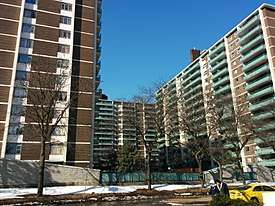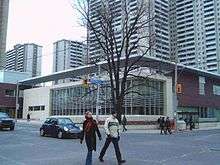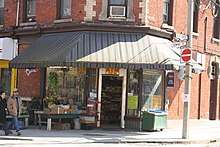St. James Town
St. James Town (sometimes misspelled St. Jamestown) is a neighbourhood of Toronto, Ontario, Canada. It lies in the northeast corner of the downtown area. The neighbourhood covers the area bounded by Jarvis Street to the west, Bloor Street East to the north, Parliament Street to the east, and Wellesley Street East to the south.
St. James Town | |
|---|---|
Neighbourhood | |
 View of St. James Town highrises from street level | |
| Country | |
| Province | |
| City | |
St. James Town is the largest high-rise community in Canada. It has been identified as one of 13 economically deprived neighbourhoods within the city. It consists of 19 high-rise buildings (14 to 32 stories). These residential towers were built in the 1960s. Officially, approximately 17,000 people live in the neighbourhood's 19 apartment towers and 4 low rise buildings, making it one of Canada's most densely populated communities.[1] A majority of the buildings are owned by the Bleeman Family, and were built by Medallion.
History
St. James Town began to grow in the 19th century when it became a semi-suburban area home to the city's middle class.

St. James Ward was rezoned in the 1950s, and the nineteenth century homes were leveled, and apartment towers — inspired by Le Corbusier's Towers in the Park concept — were erected. Each tower was named after a major Canadian city with some accommodating over a 1000 residents. The 14 story Quebec was completed in 1959, the 18 story Victoria in 1965, and The Toronto's 24 floors in 1967. In the same census time period (1961 - 1971) St. James Town's population grew to 11,462 from only 862.[2]
In the late 1960s, the developers attempted to acquire land south of Wellesley, as far as Carlton Street, to expand the St. James Town development. Many residents of the area resisted, with the support of civic activist and future Mayor of Toronto John Sewell. The St. James Town expansion was cancelled, and the homes that had been demolished were replaced with several housing cooperatives.
The plan for St. James Town's highrises was conceived in the 1950s to house young middle class residents who worked Downtown. This plan was spurred forward by the federal government, that saw city building as a key to post-depression, post-war, nation's recovery.[3] The buildings didn't attract the large number of demographics the developer envisioned, as well the neighborhood was designed with a lack of proper amenities to support the density spike.[3] Happening parallel to the development of St. Jamestown, was large suburban developments of detached family homes in the Toronto's suburbs. Many prospective tenants instead chose suburban houses in the developing areas of Scarborough, Etobicoke and North York. After the first generation of tenants left the buildings, the area quickly started attracting tenants of a lower income bracket. Four buildings were later built by the province to provide public housing. Today, the towers are mostly home to newly arrived immigrant families, with only 33% being born in Canada, according to the 2011 Census.

After the Provincial health care restructuring in the mid 1990s, the Princess Margret Hospital site on Sherbourne Street because available. In 2001, the City of Toronto launched a major initiative to add social amenities in the area, and began construction of a new Toronto Public Library branch and community centre, which opened in 2004 at the corner of Sherbourne and Wellesley. Lanterra Developments has also proposed plans to replace some of the remaining Victorian homes in St. Jamestown with several more towers.[4]
On September 24, 2010, a fire broke out on the 24th floor of 200 Wellesley St East (the white building behind the library and community centre). Fourteen people were taken to hospital due to injuries, including three firefighters and two children; three of the injuries were classed as serious. The cause of the fire was determined to be a cigarette thrown from a balcony above.[5]
In 2013, St. James Town became the host of the World's Tallest Mural, pending approval by Guinness.[6]
On August 21, 2018, a fire broke out in an electrical box at 650 Parliament St. Only two people suffered minor injuries, but the entire building, containing 1,500 or more people, had to be evacuated. It took six hours to douse the flames. Reports indicated that evacuees would have to wait "several days" before they would be allowed to return.[7][8] As of May 2019, re-occupancy has been postponed to late that year due to the complexities of restoration work, including the discovery of the presence of a "minor amount" of asbestos.[9][10]
Demographics
Census tract 0065.00 of the 2006 Canadian census covers St. James Town. According to that census, the neighbourhood has 14,666 residents. Average income is $22,341, one of the lowest in Toronto. In the 2011 National Household Survey, the average income of residents in Ontario is reported to be $42,264. When compared to the average income of residents in this Census Tract from the 2011 Census year, this is a difference of $19,923. When further examined against the average income of residents in Canada, whereby it is reported to be $40,650 in the 2011 National Household Survey, the difference remains similar at $18,309. Both of these differences therefore shows us the sharp income disparities in this Census Tract and its resulting socio-economic impacts on its residents (Census 2006, Census 2011). In addition, this can be seen in the income distribution of the neighbourhood in 2011 with 57% of the inhabitants earning less than $19,999 and only 6% earning more than $60,000. In fact the majority of individuals (82.6%) over the age of 15 earn an income of less than $39,999 before tax. Due to its cultural and minority demographics, St. James Town is often thought as "the world within a block". It is largely filled with immigrants — especially those who arrived in the 1990s. The ten most common languages in the neighbourhood, after English, are:
- Tagalog - 8.1%
- Tamil - 5.5%
- Unspecified Chinese - 2.5%
- Mandarin - 2.5%
- Korean - 1.9%
- Spanish - 1.8%
- Russian - 1.8%
- Serbian - 1.4%
- Bengali - 1.4%
- Urdu - 1.4%
The diversity of the neighbourhood can be further supported by the fact that in 2011, 59% of the population identified as an immigrant. An immigrant is one who is citizen of Canada and has moved to Canada from somewhere else. 8% of the population identified as non-permanent residents and 33% identified as non-immigrants.[11]
The disproportional number of renters to owners in this area has been explored on the 2006 and 2011 census and the numbers tell a troubling story about the falling number of property owners in this census Tract area. The data suggest in 2006, 50 people owned one of the limited number of older model properties in the area but by 2011 that number had fallen to 40. This however could be in correlation to the fall in the overall population in the area. Though the area is seeing improvements in terms of access to amenities the population has indeed dropped from 14,666 to 13,910 between census years 2006 and 2011. (census 2006, census 2011)
In terms of the 2011 National Household Survey, there was Global Non-Response rate of 21.7% which means that only 25.8% of the population completed the survey. This number is actually higher than the 20% response rate of the 2006 Long Form census, however due to the voluntary nature of the census, the data is not as reliable compared to the mandatory long form census of 2006. This is because when it is a voluntary census rather one required by law, there is a high chance of non-response bias especially as the GNR grows larger which means that there is a higher chance that those who are responding to the voluntary survey is not completely randomized. In comparison to Canada, which has a GNR of 26.1%, and Ontario, which has a GNR of 27.1%, CT5350065.0 has a lower GNR rate which that there may be less of a non-response bias.[11]
Generation Status
According to the 2006 long form census and the 2011 National Household Survey the majority of individuals in St. James Town (census tract 5350065.00) would be categorized as being of first generation status (Statistics Canada, 2006; Statistics Canada, 2011).[12][13] First generation status applies to people who were born outside of Canada (Statistics Canada, 2011).[14] Second generation refers to people born in Canada but their mother and father were born outside of Canada (Statistics Canada, 2011).[14] The final category, third generation and more, covers people who were born and Canada and both their mother and father were also born in Canada (Statistics Canada, 2011).[14]
The following is a breakdown of the percentages of those considered first, second, and third generation or more in St. James Town in both 2006 and 2011.
2006:
First Generation Status: 78%
Second Generation Status: 8%
Third Generation Status and more: 14%
2011:
First Generation Status: 67%
Second Generation Status: 20%
Third Generation Status and more: 13%
From 2006 to 2011 the biggest change in the generation status occurred in the second-generation category where those considered second generation rose 12% from 8% to 20%. This indicates that individuals that were born in Canada with a mother or father born outside of Canada increased from 2006 to 2011. First generation status, on the other hand, decreased (despite still containing the majority of the population both years) and those considered third generation and more decreased by 1%. It can therefore be concluded that the majority of people living in St. James Town were not born in Canada according to both the 2006 long form census (where they accounted for 78% of those who completed the survey) and the 2011 National Household Survey (where they accounted for 67% of those who completed the survey). This information can be related to previously mentioned data on income and immigration status and diversity.
In 2006 the long form census had a 20% completion rate compared to the 2011 National Household Survey, which had a 25.85% completion rate. Therefore, more people completed the survey in 2011 compared to 2006, but as previously mentioned, one must be aware of a possibility of a non-response bias, meaning those answering the survey might not be random and may have affected the data.
Immigrant Status
In 2006, there was a total of 14, 666 residents in St. James Town. Of this population, 14, 606 identified themselves as an immigrant. In 2011 (Global Non-Response Rate: 21.7)* (Statistics Canada, 2006; Statistics Canada, 2011).,[12][13] the population dropped by 632 people to 13, 974 people (Statistics Canada, 2006; Statistics Canada, 2011).[12][13] Of this population 8,180 stated that they were immigrants on the census. Although there was not a significant drop in population there was a significant drop of 6, 426 immigrants that no longer live in the area according to the 2006 long census form survey and 2011 National Household Survey (Statistics Canada, 2006; Statistics Canada, 2011).[12][13]
Non-residential content

In October 2009, St. James Town contained the following businesses, organizations and institutions:
- Rose Avenue Public School, a Toronto Board of Education school for Kindergarten through grade 6, on Ontario Street north of St. James Avenue
- a community centre and branch of the Toronto Public Library, at the intersection of Sherbourne Street and Wellesley Street East
- a Food Basics at Ontario Street and Wellesley Street East. Previously, a No Frills had also operated at Sherbourne Street and Earl Street, but the grocer lost its lease effective as of July 2013. In October 2015, the owner of the No Frills formerly located on Sherbourne Street reopened a new store two blocks away at the Greenwin Plaza shopping centre located at 345 Bloor Street East.
- a FreshCo on Sherbourne Street, on the Eastside near Isabella Street.
- three pharmacies, including a Shoppers Drug Mart box store on Sherbourne Street near Howard Street, an independent pharmacy on Howard Street at Bleecker Street, and an independent pharmacy on Ontario Street south of St. James Avenue
- at least six convenience stores, two on Howard Street, two on Sherbourne Street, one on Ontario Street south of St. James Avenue, and one on Wellesley Street East
- a food bank at the rear of the building on 275 Bleecker Street
- The St. James Town Youth Council, a body of community youth who meet regularly to address issues in their community. Currently, they host an annual talent show called "Urban Flair" featuring performances by local youth. This competition allows members of the community to support each other and provides an opportunity for new and upcoming stars to take to the stage.
- The St. Jamestown Community Cafe was launched in 2011. This pay-what-you-can cafe hopes to find a permanent home and establish Toronto's first community powered PWYC eating establishment while also providing a place for community members to interact and be entertained. The cafe founders also hope to provide an incubator for other community organizations interested in developing and establishing their own neighbourhood's version of a community powered pwyc cafe.[15]
Notable residents
- Olivia Chow, former Member of Parliament and city councillor
- Stephan James, actor, most notable for his role as Jesse Owens in the 2016 film Race
See also
| Wikimedia Commons has media related to St. James Town. |
- Sherbourne (TTC)
- List of neighbourhoods in Toronto
References
- Fun with the Census: Where’s the densest place in North America?
- "Statistics Canada." Government of Canada, Statistics Canada. Web. Accessed 31 Mar. 2014.
- Caulfield, Jon. City form and everyday life: Toronto's gentrification and critical social practice. Toronto: University of Toronto Press, 1994
- Landau, Jack. Lanterra's North St James Town Proposal Resurfaces Urban Toronto. 28 February 2013
- Powell, Betsy (30 September 2013). "200 Wellesley St. fire: 600 tenants to share in $4.85M compensation". The Toronto Star. Archived from the original on 30 September 2013. Retrieved 1 October 2013.
The fire, which caused more than $1 million in damage, broke out Sept. 24, 2010, in a 24th floor unit, after a discarded cigarette landed on a balcony filled with an “excessive amount of combustible materials,” according to the Office of the Fire Marshal.
- "Toronto teens and artists create what could be world's tallest mural". CBC News. Retrieved 25 November 2013.
- Bañares, Ilya (21 August 2018). "Six-alarm fire in St. James Town forces hundreds to evacuate". The Toronto Star. Retrieved 22 August 2018.
- "Residents displaced by Parliament Street blaze not likely to return home for several days". CBC News. Retrieved 22 August 2018.
- "Estimated return date for displaced 650 Parliament residents extended yet again | CBC News".
- "650 Parliament: Update June 16, 2019".
- Statistics Canada's 2011 Census of Canada 2012
- "2011 Census of Population Program reference materials". 16 November 2016.
- "2006 Census reference materials".
- "Place of Birth, Generation Status, Citizenship and Immigration Reference Guide". 8 May 2013.
- "Modern Times: Nourishment 101". 21 November 2011.